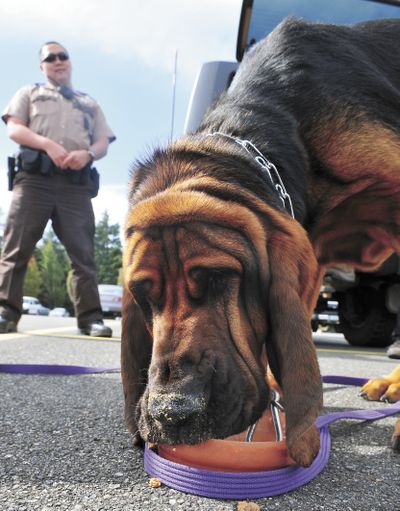Coos County tracker retiring
ACL injury forces Franklyn out early

COOS BAY, Ore. – A golden Lab growling and pacing behind a fence just a few feet away has no effect on Coos County’s pre-eminent hunter, whose nose stays low to the ground as the scent he tracks pulls his 98-pound frame along a fence at Southwestern Oregon Community College.
“Work, Franklyn,” says handler Ed Makaruk. “Work.”
Franklyn, Coos County’s award-winning bloodhound, weaves his way through an opening in the fence, following the scent along bushes that lead to the Newmark Center parking lot.
The sniffing noise that accompanies his long ears dragging on the asphalt gets louder as he nears his subject.
“Find,” Makaruk says. “Find.”
Moments later, a bellowing howl, followed by a lift of a paw, indicates Franklyn has “rescued” his intended target behind a Jeep.
A small circle of people, including members from Coos County Search and Rescue, congratulate the slobbering hound on the success of his mock mission. It’s his last as a working dog.
Due to an anterior cruciate ligament injury, 5-year-old Franklyn will retire from Search and Rescue and become the mascot for the agency, whose motto is, “So others may live.”
“These dogs are the ones that pay the price,” Makaruk said. “I’m dealing with injuries at 5 that you would see in a 10-year-old.”
It’s that sacrifice and the uncanny ability to accurately track human scent that has led to the increased role bloodhounds play in law enforcement agencies across the country.
Master Trainer Duke Snodgrass, who runs 832 K-9’s Deputy Dogs – an elite bloodhound breeding and training center in Inverness, Fla. – said while every bloodhound doesn’t turn out to be a tracking dog, they are born to hunt.
“They are the only tool in the box that can do what they can do,” he said. “Agencies are starting to figure that out.”
Snodgrass will give Makaruk, and ultimately Search and Rescue, a 15-month-old bloodhound from his distinct line of breeds – at a discounted price – to replace Franklyn.
Snodgrass, who took a keen interest in training bloodhounds after his sister-in-law was abducted and subsequently found dead 28 years ago, started 832 Deputy Dogs as part of a memorial foundation for his late son, Deputy Kody Snodgrass, who died in a motorcycle accident.
Snodgrass said each person emits an odor throughout his or her life that is like a fingerprint. Bloodhounds, he said, have the noses and abilities to track the fatty gases.
Makaruk agrees that the hounds’ incredible noses and long ears, which sweep scents to their nose, make for ideal hunters.
“Form follows function,” he said. ‘It’s like a tunnel going into their nose.”
Snodgrass said that while there are ways to try to hide the gases, his hounds can track the last person to touch a pipe bomb after it has exploded.
“We can take gas cans and burn them to liquid, and the dog can tell who the last person to handle it was,” he said.
Makaruk flew recently to Florida, where he will work with the new hound and Snodgrass before heading to Indiana to run tracks and train at The American Maintrailing, Police and Work Dog Association.
There, Makaruk will try to build a relationship with the young hound as he built with Franklyn.
“It’s hard to describe the bond we have,” he said. “If I am having a bad day he knows it. I can speak to him without talking.”